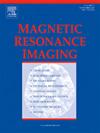Noise-robust foreground segmentation of multispectral imaging calibration volume in the presence of metallic implants for spectral range estimation in phantom and in-vivo data
IF 2
4区 医学
Q2 RADIOLOGY, NUCLEAR MEDICINE & MEDICAL IMAGING
引用次数: 0
Abstract
Purpose
Multispectral Imaging (MSI) methods can use a calibration scan to estimate an off-resonance field-map to determine the spectral range required to cover off-resonant signal in the presence of metallic implants of various shape and composition. Background signal noise can corrupt the field-map estimation in this calibration process. Previous work on foreground segmentation used a cumulative distribution function (CDF) to remove signal extrema, which can remove regions of true off-resonance signal from the calibration analysis.
The purpose of this work is to develop a foreground segmentation method robust to background noise in both phantom and in-vivo data to support calibrating the spectral range needed for MSI acquisitions.
Methods
The proposed method uses information from individual spectral bins, rather than a composite bin-combined image, for segmentation. Ten phantom (seven with metal) and ten in-vivo (six with metal) data were acquired using a prototype MSI spectral calibration sequence. Field-maps were estimated and spectral range estimates from the unmasked field-map and the proposed method were computed and compared using a paired sample Wilcoxon signed-rank test.
Results
The proposed method achieved a noise-robust foreground segmentation in both phantom and in-vivo data, in the presence or absence of metal devices. The Wilcoxon test showed a statistically significant difference between the spectral range estimates from the unmasked field-map and proposed method for both the phantom and in-vivo data (p-value: 0.002).
Conclusion
Noise-robust foreground segmentation achieved by the proposed method can improve the accuracy and robustness of spectral range estimates for time-efficient and reduced artifact multispectral imaging.
存在金属植入物的多光谱成像校准体的噪声鲁棒前景分割,用于幻影和体内数据的光谱范围估计
多光谱成像(MSI)方法可以使用校准扫描来估计非谐振场图,以确定在各种形状和成分的金属植入物存在时覆盖非谐振信号所需的光谱范围。在此校准过程中,背景信号噪声会破坏场图估计。以前的前景分割工作使用累积分布函数(CDF)去除信号极值,这可以从校准分析中去除真正的非共振信号区域。这项工作的目的是开发一种前景分割方法,在幻影和活体数据中对背景噪声都具有鲁棒性,以支持校准MSI采集所需的光谱范围。方法利用单个光谱箱的信息进行分割,而不是使用复合的组合图像进行分割。使用原型MSI光谱校准序列获得10个幻影(7个金属)和10个体内(6个金属)数据。利用配对样本Wilcoxon带符号秩检验,估计了场图,并计算了从未掩码场图和所提出方法得到的光谱范围估计值。结果所提出的方法在存在或不存在金属装置的情况下,都实现了对假体和活体数据的噪声鲁棒前景分割。Wilcoxon检验显示,对于幻影和活体数据,从未遮挡的场图和提出的方法估计的光谱范围之间存在统计学显著差异(p值:0.002)。结论该方法实现的抗噪前景分割可提高光谱范围估计的精度和鲁棒性,实现高效、低伪影的多光谱成像。
本文章由计算机程序翻译,如有差异,请以英文原文为准。
求助全文
约1分钟内获得全文
求助全文
来源期刊

Magnetic resonance imaging
医学-核医学
CiteScore
4.70
自引率
4.00%
发文量
194
审稿时长
83 days
期刊介绍:
Magnetic Resonance Imaging (MRI) is the first international multidisciplinary journal encompassing physical, life, and clinical science investigations as they relate to the development and use of magnetic resonance imaging. MRI is dedicated to both basic research, technological innovation and applications, providing a single forum for communication among radiologists, physicists, chemists, biochemists, biologists, engineers, internists, pathologists, physiologists, computer scientists, and mathematicians.
 求助内容:
求助内容: 应助结果提醒方式:
应助结果提醒方式:


